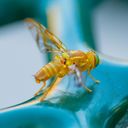Chyromyidae
Chyromyidae
Classification
- Phylum: Arthropoda
- Subphylum: Hexapoda
- Class: Insecta
- Order: Diptera
- Superfamily: Sphaeroceroidea
- Family: Chyromyidae
Pronunciation
How to pronounce Chyromyidae: /kaɪˈrɒmiˌaɪdiː/
These audio files are automatically generated. While they are not always 100% accurate, they are a good starting point.
Images





Summary
Chyromyidae, a small family of acalyptrate flies, consists of about 150 species worldwide, predominantly found in northern regions. Their biology is poorly understood, but they are associated with bird and mammal nests and have been reared from various organic substrates.
Physical Characteristics
Small to very small cyclorrhaphous, acalyptrate flies with a pale yellow integument and bright iridescent green, red, or purple eyes. Adults range from 1-3 mm in size.
Identification Tips
Presence of small size (1-3 mm), pale yellow body coloration, and bright iridescent eyes in various colors can help in identification.
Habitat
Larvae are found in bird nests, mammal burrows, and rotting wood; adults are typically collected on flowering plants and vegetation.
Distribution
Chyromyidae is represented on all continents except Antarctica, with about 150 named species worldwide, primarily located in northern regions.
Diet
Larvae may feed on organic matter found in bird nests, mammal burrows, and rotting wood. Adult dietary habits are not well documented, but they have been found on flowering plants.
Ecosystem Role
Chyromyidae contribute to the decomposition of organic matter as larvae feed on decomposing material, possibly indicating a role in nutrient cycling.
Collecting Methods
- Net collection from flowering plants
- Sampling from bird nests and mammal burrows
Preservation Methods
- Pinning
- Drying
Evolution
The family has a complex taxonomy with ongoing studies indicating that more genera may exist, especially in the African species.
Misconceptions
Due to their small size and infrequent encounters, Chyromyidae are often overlooked or confused with other small flies in the Diptera order.
Tags
- Chyromyidae
- Diptera
- Insects
- Entomology